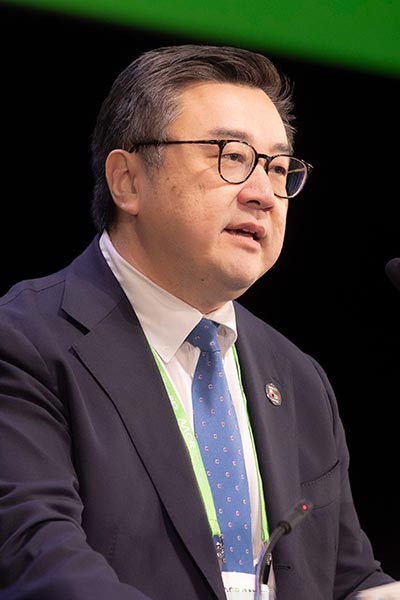Second Clinical Trials Plenary Session features new WRN, KRAS, and BRAF inhibitors
Sunday’s second Clinical Trials Plenary Session added to the slate of impactful clinical research presented at the AACR Annual Meeting 2025 by showcasing new targeted therapy approaches in solid tumors.

“We were lucky to receive a number of really interesting and impactful abstracts this year,” said session cochair Ryan B. Corcoran, MD, PhD, from Mass General Hospital. Corcoran served as a cochair of this year’s Annual Meeting Clinical Trials Committee, which puts together the clinical trials program. “This session is no exception,” he continued.
The second Clinical Trials Plenary Session, New Frontiers in Precision Oncology, highlighted inhibitors of BRAF, KRAS, and the Werner helicase (WRN), as well as a topical treatment for rashes caused by inhibitors of the epidermal growth factor receptor (EGFR).
First-in-human WRN inhibitor elicits clinical responses
The session began with promising data about WRN, a drug target that researchers have been working to effectively inhibit for several years.
“WRN inhibition represents a synthetic lethal vulnerability and therapeutic opportunity in cancers with microsatellite instability (MSI),” explained Timothy A. Yap, MBBS, PhD, from The University of Texas MD Anderson Cancer Center. He added that cancers with mismatch repair deficiency (dMMR) are also potentially vulnerable.

In a first-in-human trial of the WRN inhibitor RO7589831, Yap and colleagues treated 44 patients with previously treated solid tumors marked by MSI and/or dMMR with RO7589831. To date, 15.9% of patients have experienced grade 3 treatment-related adverse events, and no grade 4, grade 5, or dose-limiting toxicities have been observed.
In the efficacy-evaluable population of 35 patients, 14.3% experienced partial responses and 65.7% experienced disease control.
“This is the first early proof of concept for effectively targeting WRN,” Yap said.
Paradox-breaking BRAF inhibitor benefits patients, including those with brain metastases
BRAF inhibitors have been approved for tumor-agnostic use in solid tumors that have a BRAF V600E mutation. However, BRAF inhibitors must often be given as part of a combination therapy regimen, as they can paradoxically upregulate upstream signaling from the epidermal growth factor receptor (EGFR), dampening the efficacy of the therapy.

Researchers are now designing new generations of BRAF inhibitors geared toward breaking the paradox to enhance therapeutic efficacy. María Vieito, MD, from the Vall d’Hebron Institute of Oncology, and colleagues tested the BRAF inhibitor RG6344 as a monotherapy in patients with BRAF V600-mutated solid tumors. In 64 evaluable patients, the objective response rate was 24.2%, and the disease control rate was 80.3%. The cohort of patients who experienced a response included patients who had been previously treated with other BRAF inhibitors and those who had brain metastases.
“RG[6344] is part of a new generation of BRAF inhibitors with paradox-breaker properties,” Vieito said. “Emerging data we have presented today support a well-differentiated safety and tolerability profile with sustained target inhibition and early signs of single-agent antitumor activity.”
Topical BRAF blockade soothes rash from EGFR inhibitors
Although the paradoxical EGFR activation observed during treatment with BRAF inhibitors can hinder cancer treatment efforts, Anisha B. Patel, MD, from The University of Texas MD Anderson Cancer Center, and colleagues are using the paradox to their benefit—to tackle a side effect.

Up to 90% of patients taking EGFR inhibitors for cancer develop an acneiform rash, which can be painful and itchy and can negatively impact treatment adherence, Patel explained. Because BRAF inhibition can reactivate EGFR signaling as an escape mechanism, Patel and colleagues reasoned that local application of a BRAF inhibitor may restore EGFR signaling at the site of the rash and thereby mitigate the symptoms.
“What makes this inhibitor so unique is the mechanism of action,” Patel said. “As opposed to most of the therapies we have for EGFR inhibitor-induced acneiform eruption, which are symptom-directed, this actually works on the mechanism of the rash.”
The researchers enrolled 118 patients who developed an acneiform rash while receiving an EGFR inhibitor to treat their colorectal cancer. They randomly assigned patients to receive the BRAF inhibitor LUT014 gel or a placebo gel for 28 days.
The treatment success rate, defined as a one-grade or greater decrease in rash severity and/or improvement in at least five skin-specific quality-of-life criteria, was 69% among patients treated with 0.1% LUT014, 47.5% among patients treated with 0.03% LUT014, and 33% among patients treated with the placebo gel. Additionally, significantly fewer patients treated with LUT014 discontinued EGFR inhibitors than those treated with the placebo gel.
Novel KRAS G12D inhibitor shows promising efficacy in patients with lung cancer
The session concluded with good news for researchers targeting KRAS, a historically undruggable target that has made headlines in recent years with the approval of two drugs designed to target the KRAS G12C mutation. Despite the success of KRAS G12C inhibitors, no therapies have been approved yet for other KRAS mutations, including KRAS G12D.

Kathryn C. Arbour, MD, from Memorial Sloan Kettering Cancer Center, and colleagues conducted a phase I clinical trial assessing the safety and efficacy of zoldonrasib, a RAS(ON) tricomplex KRAS G12D inhibitor, in patients with KRAS G12D-mutated solid tumors that have received at least one previous line of treatment. The efficacy analysis included 18 patients with non-small cell lung cancer (NSCLC) who, at the time of data cut off, had been enrolled for at least eight weeks. The objective response rate of these patients was 61%, and the disease control rate was 89%.
“Zoldonrasib has demonstrated encouraging preliminary antitumor activity in patients with non-small cell lung cancer harboring a KRAS G12D mutation,” Arbour said. “Preliminary safety and antitumor activity support the continued development of zoldonrasib as monotherapy, and it’s also being explored in combination with other therapies.”
More from the AACR Annual Meeting 2025
View a photo gallery of scenes from Chicago, continue the conversation on social media using the hashtag #AACR25, and read more coverage in AACR Annual Meeting News.

